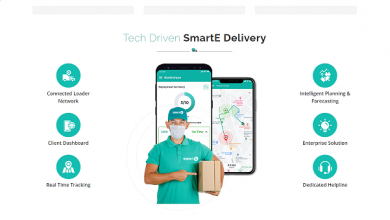Fleet management trends 2023: EVs & Telematics evolution

The landscape of transportation is undergoing a profound transformation as electric vehicles (EVs) gain traction. In the realm of fleet management for 2023, the rise of EVs is poised to redefine strategies and operations significantly, especially when coupled with advanced GPS fleet vehicle tracking technology. This dynamic convergence promises not only cost efficiencies but also a substantial reduction in environmental impact, marking a pivotal turning point for businesses reliant on vehicle fleets.
The surge in EV adoption among fleet managers is driven by a compelling fusion of factors, with GPS fleet vehicle tracking systems playing a crucial role in optimizing this transition. This article takes an in-depth look at the ascension of electric vehicles within the context of fleet management, dissecting the imperative of environmental sustainability, the allure of reduced operational costs, government incentives, and the inherent fuel efficiency of EVs, all while leveraging the continuous evolution of EV technology with the precision of GPS fleet vehicle tracking.
However, as fleet managers embark on this electrifying journey, they must grapple with a set of formidable challenges. These include the initial investment, the development of charging infrastructure, concerns related to range anxiety, vehicle availability, and the consideration of charging times—all of which necessitate careful planning and innovative solutions, further underscored by the invaluable insights provided by GPS fleet vehicle tracking systems.
As businesses across various industries embrace EVs as a cornerstone of their fleet management strategies, they stand to gain not only from reduced operating costs but also from making a positive impact on the environment. The transformational shift toward electrification within fleet management promises a future that is not only more sustainable and efficient but also intricately intertwined with the precise data-driven capabilities of GPS fleet vehicle tracking systems. In 2023 and beyond, this convergence of EVs and GPS tracking stands as a trend that simply cannot be overlooked.
The Rise of Electric Vehicles (EVs) in Fleet Management
The adoption of electric vehicles (EVs) in fleet management is experiencing an unprecedented surge, and the trend is set to redefine the way businesses manage their vehicle fleets in 2023. Several driving factors are contributing to the rapid ascent of EVs in fleet management, along with key challenges that fleet managers need to navigate:
- Environmental Sustainability: Environmental consciousness and sustainability have become central themes across industries. In response, many fleet managers are turning to EVs as a proactive measure to reduce their carbon footprint. Unlike traditional internal combustion engine (ICE) vehicles, EVs produce zero tailpipe emissions, making them a cleaner and more eco-friendly option.
- Lower Operating Costs: EVs are known for their lower operating costs compared to ICE vehicles. The primary cost-saving aspect lies in the price of electricity versus gasoline or diesel fuel. Electricity is generally more affordable, and this translates to considerable savings over the lifetime of an EV. Furthermore, EVs have fewer moving parts, resulting in reduced maintenance and repair expenses, which is a significant factor in fleet management budgets.
- Government Incentives: Governments around the world are actively promoting the adoption of EVs through a variety of incentives. These incentives can include tax credits, rebates, reduced registration fees, access to carpool lanes, and exemptions from congestion charges. These financial incentives make EVs an attractive choice for fleet managers looking to maximize their return on investment.
- Fuel Efficiency: EVs are inherently more energy-efficient than their ICE counterparts. They convert a higher percentage of the energy from the electric grid into vehicle movement, reducing energy waste. Additionally, the price of electricity tends to be more stable than that of fossil fuels, offering greater predictability in fleet operating costs.
- Advancements in EV Technology: The evolution of EV technology is addressing many concerns that previously hindered their widespread adoption. Battery capacity is increasing, leading to longer ranges on a single charge. Charging infrastructure is expanding rapidly, reducing concerns about range anxiety. Moreover, advancements in battery technology are driving down costs, making EVs more affordable.
Challenges of EV Adoption in Fleet Management
While the benefits of EV adoption are compelling, fleet managers must navigate certain challenges when incorporating EVs into their operations:
- Upfront Costs: EVs generally have a higher upfront purchase price compared to traditional vehicles. However, as technology advances and economies of scale come into play, the price gap is narrowing. Moreover, lower operating costs and potential government incentives can offset the initial investment over time.
- Charging Infrastructure: To support EVs, fleet managers need to invest in charging infrastructure. This can be a significant expense, especially for large fleets with multiple vehicles. While public charging networks are growing, organizations may need to establish their own charging stations, which require careful planning and investment.
- Range Anxiety: Range anxiety, the fear of running out of battery power without access to charging, is a concern for some fleet managers, especially in applications that require long-distance travel. Effective route planning and access to charging infrastructure are crucial in alleviating this concern and ensuring seamless operations.
- Vehicle Availability: The demand for EVs is surging, leading to increased production by automakers. However, there may still be waiting periods for certain EV models, impacting fleet expansion plans. Fleet managers should consider lead times when incorporating EVs into their fleets.
- Charging Time: Charging an EV takes longer than refueling a traditional vehicle with gasoline or diesel. Fleet managers need to factor in charging times when planning routes and schedules. Fast-charging options are becoming more common and can reduce downtime.
Telematics Evolution: Emphasizing GPS Fleet Vehicle Tracking
Telematics, the integrated use of telecommunications and informatics in vehicles and monitoring systems, has come a long way since its inception. In 2023, the evolution of telematics takes center stage, with a particular emphasis on GPS fleet vehicle tracking. Let’s delve deeper into this pivotal aspect of telematics and understand why it’s at the forefront of fleet management trends:
- Real-Time Vehicle Location and Visibility: GPS fleet vehicle tracking has evolved to provide real-time location data with remarkable precision. Modern telematics systems offer fleet managers the ability to track their vehicles on a digital map with accuracy down to a few meters. This level of visibility is crucial for optimizing routes, ensuring on-time deliveries, and enhancing overall fleet efficiency.
- Geofencing and Location-Based Alerts: Advanced telematics systems now include geofencing capabilities, allowing fleet managers to define virtual boundaries or geographical zones. When a vehicle enters or exits these predefined areas, the system triggers automated alerts. This feature is invaluable for improving security, monitoring vehicle access to restricted zones, and ensuring compliance with specific geographic regulations.
- Historical Route Data and Analysis: Telematics systems not only provide real-time tracking but also store historical route data. Fleet managers can access detailed records of past journeys, enabling them to analyze routes, driving patterns, and time spent at various locations. This historical data aids in route optimization, identifying areas for improvement, and making informed decisions to enhance overall fleet performance.
- Integration with Advanced Technologies: Telematics platforms are increasingly integrating with other advanced technologies, such as Internet of Things (IoT) sensors and connected vehicle systems. This convergence enhances the capabilities of telematics by enabling vehicles to communicate with each other and with infrastructure elements. For example, vehicles can share data on road conditions, traffic congestion, and weather conditions, allowing for dynamic route adjustments in real time.
- Predictive Analytics and Maintenance: The evolution of telematics includes the incorporation of predictive analytics. By analyzing vehicle data, telematics systems can predict when maintenance will be required, identify potential issues before they become major problems, and provide insights into fleet performance. This data-driven approach to maintenance planning reduces downtime, improves vehicle reliability, and optimizes maintenance costs.
- Driver Behavior Monitoring and Safety: Telematics systems play a crucial role in monitoring driver behavior. They track metrics such as speeding, harsh braking, acceleration, and adherence to traffic regulations. Fleet managers can use this information to identify risky driving behaviors and implement targeted driver training programs to improve safety on the road. In this way, telematics not only enhances efficiency but also prioritizes safety.
- Enhanced Reporting and Data Visualization: Telematics platforms have evolved to offer advanced reporting and data visualization features. Fleet managers can access customized reports and dashboards that provide insights into various aspects of fleet operations, from fuel consumption to vehicle utilization. These tools facilitate data-driven decision-making, allowing fleet managers to make informed choices that lead to cost savings and operational improvements.
- Sustainability and Environmental Monitoring: Telematics systems are increasingly incorporating features that support sustainability efforts. By monitoring vehicle emissions, fuel consumption, and idling times, fleet managers can identify opportunities to reduce their environmental footprint. This aligns with the growing emphasis on sustainability in fleet management and helps organizations meet their eco-friendly objectives.
Environmental Considerations and Sustainability
Sustainability remains a central theme in fleet management. As businesses seek to reduce their carbon footprint and meet environmental goals, fleet managers are implementing eco-friendly practices. Here’s how sustainability considerations are shaping fleet management in 2023:
- EV Adoption: The transition to electric vehicles aligns with sustainability objectives. EVs produce zero tailpipe emissions, reducing greenhouse gas emissions and air pollution. Fleet managers are increasingly incorporating EVs into their operations to support sustainability goals.
- Route Optimization: Telematics systems play a critical role in route optimization, helping fleets reduce fuel consumption and minimize emissions by selecting the most efficient routes. This practice not only saves costs but also contributes to environmental conservation.
- Idle Reduction: Telematics systems can monitor and reduce vehicle idling, which is a significant contributor to fuel consumption and emissions. By addressing excessive idling, fleets can lower their environmental impact.
- Eco-Driving Programs: Fleet managers are implementing eco-driving programs that encourage drivers to adopt fuel-efficient driving behaviors. These programs can lead to substantial fuel savings and reduced emissions.
- Sustainability Reporting: Many businesses are now including sustainability reporting as part of their corporate social responsibility initiatives. Fleet managers are instrumental in providing data and insights on fleet-related sustainability metrics.
Final Thoughts
In 2023, the fleet management landscape is evolving rapidly, driven by the adoption of electric vehicles and the continuous evolution of telematics with a focus on GPS fleet vehicle tracking. The benefits of EVs, including environmental sustainability, lower operating costs, and government incentives, are making them an attractive choice for fleet managers. Challenges such as upfront costs and charging infrastructure are being addressed as technology and infrastructure advance.
Telematics, on the other hand, is becoming increasingly sophisticated, offering enhanced vehicle tracking, geofencing, predictive analytics, and integration with advanced technologies. Telematics is a key enabler of sustainability initiatives in fleet management, helping reduce emissions, optimize routes, and improve overall efficiency.
As businesses prioritize sustainability, efficiency, and data-driven decision-making, fleet managers are at the forefront of implementing these trends and shaping the future of fleet management in 2023 and beyond. Embracing electric vehicles and harnessing the power of telematics will be essential steps in this ongoing transformation, leading to greener, more efficient, and sustainable fleet operations.
About the author:

Alexis Nicols is a dynamic creative professional renowned for her writing and content creation skills. Her words, ranging from thought-provoking essays to captivating fiction, captivate readers across various genres. Alexis’s work has graced the pages of numerous publications, showcasing her dedication to excellence in storytelling and content strategy.



